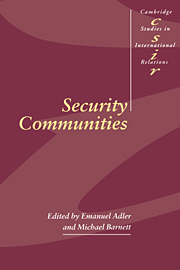Book contents
- Frontmatter
- Contents
- Notes on contributors
- Acknowledgements
- Part I Introduction and theoretical overview
- Part II Studies in security communities
- 3 Insecurity, security, and asecurity in the West European non-war community
- 4 Seeds of peaceful change: the OSCE's security community-building model
- 5 Caravans in opposite directions: society, state and the development of a community in the Gulf Cooperation Council
- 6 Collective identity and conflict management in Southeast Asia
- 7 An emerging security community in South America?
- 8 Australia and the search for a security community in the 1990s
- 9 The United States and Mexico: a pluralistic security community?
- 10 No fences make good neighbors: the development of the US-Canadian security community, 1871–1940
- 11 A neo-Kantian perspective: democracy, interdependence and international organizations in building security communities
- Part III Conclusions
- Index
- CAMBRIDGE STUDIES IN INTERNATIONAL RELATIONS
10 - No fences make good neighbors: the development of the US-Canadian security community, 1871–1940
Published online by Cambridge University Press: 30 October 2009
- Frontmatter
- Contents
- Notes on contributors
- Acknowledgements
- Part I Introduction and theoretical overview
- Part II Studies in security communities
- 3 Insecurity, security, and asecurity in the West European non-war community
- 4 Seeds of peaceful change: the OSCE's security community-building model
- 5 Caravans in opposite directions: society, state and the development of a community in the Gulf Cooperation Council
- 6 Collective identity and conflict management in Southeast Asia
- 7 An emerging security community in South America?
- 8 Australia and the search for a security community in the 1990s
- 9 The United States and Mexico: a pluralistic security community?
- 10 No fences make good neighbors: the development of the US-Canadian security community, 1871–1940
- 11 A neo-Kantian perspective: democracy, interdependence and international organizations in building security communities
- Part III Conclusions
- Index
- CAMBRIDGE STUDIES IN INTERNATIONAL RELATIONS
Summary
The durable peace between the United States and Canada has nowadays become an afterthought. It is simply unimaginable to most observers, except perhaps in satire, that the two North American countries could fight a war over any issue that is likely to arise. As 5,000 miles (and 125 years) of undefended border attest, neither side regards the other as even a potential military threat, despite the fact that interstate anarchy supposedly makes war an ever-present possibility. Conflicts materialize and are resolved without the expectation that they might lead to violence. The United States and Canada thus constitute a striking example of a pluralistic security community (PSC).
How and why did this PSC arise? I will argue that it was produced by two enduring and causally related processes which together promoted a sense of community and the assurance that the US and Canada would settle their disputes through pacific means. First and foremost, after the Civil War, the United States and Canada demilitarized their border. Initially, this process was based on domestic political incentives, not warm sentiment. Prior to the Cold War, Americans were generally unenthusiastic about military spending and large peacetime armies because they feared domestic repression and adventurism. American policymakers also believed that force was unnecessary and unsuitable for effecting their desired annexation of Canada. For its part, Canada disarmed after 1867, when it achieved quasiautonomy and could pass the defense buck to Britain and spend its money more effectively elsewhere.
- Type
- Chapter
- Information
- Security Communities , pp. 333 - 367Publisher: Cambridge University PressPrint publication year: 1998
- 14
- Cited by

